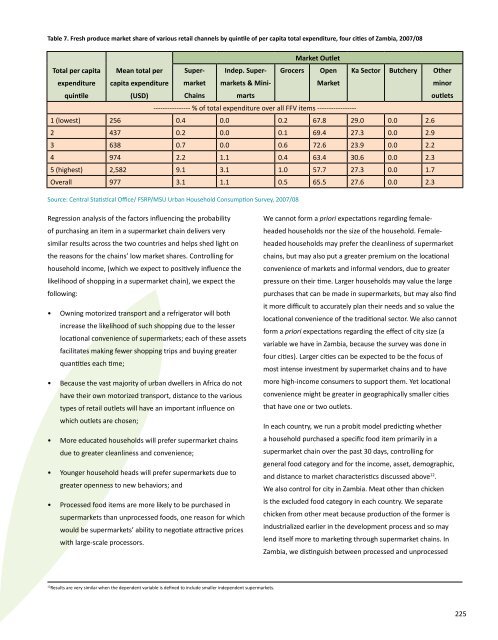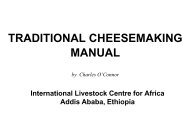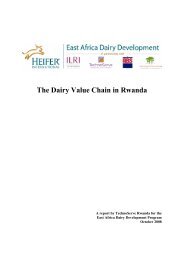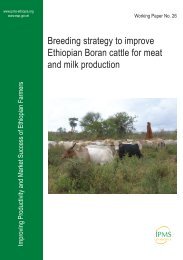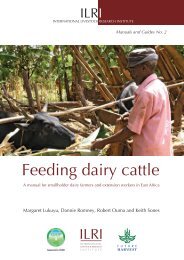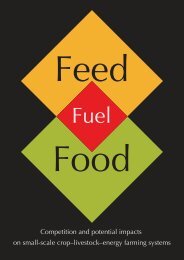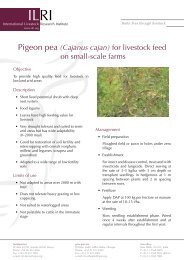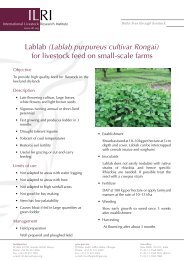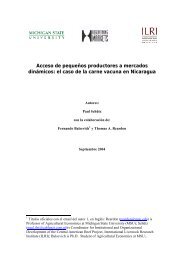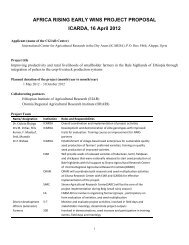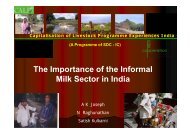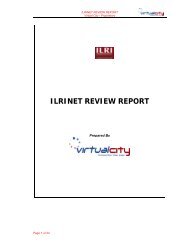High-Value Commodities and Agroprocessing - International ...
High-Value Commodities and Agroprocessing - International ...
High-Value Commodities and Agroprocessing - International ...
Create successful ePaper yourself
Turn your PDF publications into a flip-book with our unique Google optimized e-Paper software.
Table 7. Fresh produce market share of various retail channels by quintile of per capita total expenditure, four cities of Zambia, 2007/08<br />
Total per capita<br />
expenditure<br />
quintile<br />
Mean total per<br />
capita expenditure<br />
(USD)<br />
Super-<br />
market<br />
Chains<br />
Indep. Super-<br />
markets & Mini-<br />
marts<br />
Market Outlet<br />
Grocers Open<br />
Market<br />
---------------- % of total expenditure over all FFV items -----------------<br />
Ka Sector Butchery Other<br />
1 (lowest) 256 0.4 0.0 0.2 67.8 29.0 0.0 2.6<br />
2 437 0.2 0.0 0.1 69.4 27.3 0.0 2.9<br />
3 638 0.7 0.0 0.6 72.6 23.9 0.0 2.2<br />
4 974 2.2 1.1 0.4 63.4 30.6 0.0 2.3<br />
5 (highest) 2,582 9.1 3.1 1.0 57.7 27.3 0.0 1.7<br />
Overall 977 3.1 1.1 0.5 65.5 27.6 0.0 2.3<br />
Source: Central Statistical Office/ FSRP/MSU Urban Household Consumption Survey, 2007/08<br />
Regression analysis of the factors influencing the probability<br />
of purchasing an item in a supermarket chain delivers very<br />
similar results across the two countries <strong>and</strong> helps shed light on<br />
the reasons for the chains’ low market shares. Controlling for<br />
household income, (which we expect to positively influence the<br />
likelihood of shopping in a supermarket chain), we expect the<br />
following:<br />
• Owning motorized transport <strong>and</strong> a refrigerator will both<br />
increase the likelihood of such shopping due to the lesser<br />
locational convenience of supermarkets; each of these assets<br />
facilitates making fewer shopping trips <strong>and</strong> buying greater<br />
quantities each time;<br />
• Because the vast majority of urban dwellers in Africa do not<br />
have their own motorized transport, distance to the various<br />
types of retail outlets will have an important influence on<br />
which outlets are chosen;<br />
• More educated households will prefer supermarket chains<br />
due to greater cleanliness <strong>and</strong> convenience;<br />
• Younger household heads will prefer supermarkets due to<br />
greater openness to new behaviors; <strong>and</strong><br />
• Processed food items are more likely to be purchased in<br />
supermarkets than unprocessed foods, one reason for which<br />
would be supermarkets’ ability to negotiate attractive prices<br />
with large-scale processors.<br />
12 Results are very similar when the dependent variable is defined to include smaller independent supermarkets.<br />
minor<br />
outlets<br />
We cannot form a priori expectations regarding femaleheaded<br />
households nor the size of the household. Femaleheaded<br />
households may prefer the cleanliness of supermarket<br />
chains, but may also put a greater premium on the locational<br />
convenience of markets <strong>and</strong> informal vendors, due to greater<br />
pressure on their time. Larger households may value the large<br />
purchases that can be made in supermarkets, but may also find<br />
it more difficult to accurately plan their needs <strong>and</strong> so value the<br />
locational convenience of the traditional sector. We also cannot<br />
form a priori expectations regarding the effect of city size (a<br />
variable we have in Zambia, because the survey was done in<br />
four cities). Larger cities can be expected to be the focus of<br />
most intense investment by supermarket chains <strong>and</strong> to have<br />
more high-income consumers to support them. Yet locational<br />
convenience might be greater in geographically smaller cities<br />
that have one or two outlets.<br />
In each country, we run a probit model predicting whether<br />
a household purchased a specific food item primarily in a<br />
supermarket chain over the past 30 days, controlling for<br />
general food category <strong>and</strong> for the income, asset, demographic,<br />
<strong>and</strong> distance to market characteristics discussed above12 .<br />
We also control for city in Zambia. Meat other than chicken<br />
is the excluded food category in each country. We separate<br />
chicken from other meat because production of the former is<br />
industrialized earlier in the development process <strong>and</strong> so may<br />
lend itself more to marketing through supermarket chains. In<br />
Zambia, we distinguish between processed <strong>and</strong> unprocessed<br />
225


